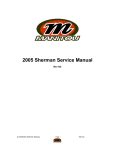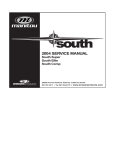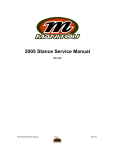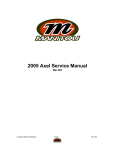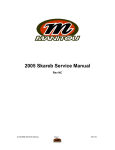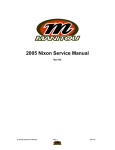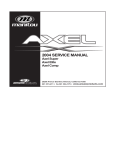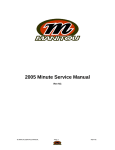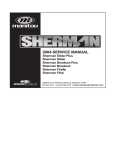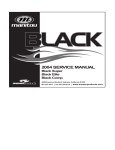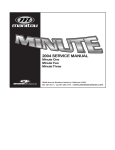Download 2005 South Service Manual
Transcript
2005 South Service Manual Rev NC 05 SOUTH SERVICE MANUAL Page 1 REV NC Table of Contents Description Page Introduction 3 Front Suspension Terminology 4 Disassembly/Assembly Instructions 8 Troubleshooting Chart 12 South Schematic and Torque Specifications 13 South Service Kit Chart 14 Contact Information Answer Products Customer Service Department 28209 Ave. Stanford Valencia, CA 91355 Toll Free: Direct: FAX: E-mail: Web site: (800) 423-0273 (661) 257-4411 (661) 775-1798 [email protected] [email protected] www.answerproducts.com 05 SOUTH SERVICE MANUAL Page 2 REV NC INTRODUCTION This manual is intended to guide the user through basic service of Manitou South front forks. Service is supported by the identification of common parts and assemblies that have been assembled into Service Kits. The purpose of this manual will be to describe conditions that may drive the need for service and to provide installation instructions for the kits. Due to the time-consuming nature suspension fork service, at this time our primary focus is to offer service kits that minimize the amount of downtime and labor involved. Important information is highlighted in this manual by the following notations: WARNING Failure to follow WARNING instructions could result in severe injury or death to the person inspecting or repairing the suspension fork or the user. CAUTION A CAUTION a caution indicates special precautions that must be taken to avoid damage to the product. NOTE A NOTE provides key information to make procedures easier or clearer GENERAL WARNING: Suspension forks by design can contain preloaded springs, gases and fluids under extreme pressure and warnings contained in this manual must be observed to reduce the possibility of injury or possible death. Following these instructions can help you reduce the risk of being injured. Any questions in regards to the information in this manual should be directed to Answer Products Customer Service at (661) 257-4411. WARNING: Suspension forks uses preloaded spring(s) to provide compression spring resistance. This system must be relieved of preload prior to servicing. Failure to relieve air pressure could result in injury or possible death. CAUTION: Suspension forks use precision machined aluminum and other soft alloy components. Using correct tools for assembly is essential to prevent damage. 05 SOUTH SERVICE MANUAL Page 3 REV NC FRONT SUSPENSION TERMINOLOGY Air Cap – Top cap that threads into top of air/spring leg (this is the left leg of the fork as you are seated on the seat). Forks may be controlled with an air/spring or a coil spring. The air cap contains the Schrader Valve, which is used to control the spring rate or SAG of air forks. Air Spring – A mechanism that is used to control the SAG of an air fork. Arch – A support that connects the two outer lower legs of the casting so as to keep them moving in unison. Black Nitrate Leg Coating – New coating for steel stanchion legs that reduces stiction. Boss – The word used to describe an outer casting that has brake posts for V-brakes or cantilever brakes. Bottom Out Bumper – A rubber or elastomer device that absorbs the shock that occurs when a suspension is compression to its limit. Bushings – A cylindrical sleeve between a fork stanchion tube (inner leg) and a fork outer casting (slider), which facilitates the sliding movement between these two parts. Coil Spring Air Assist – A new feature for 2005 that utilizes a full length coil spring and allows you to increase the spring rate of the fork by adding air as a booster to that coil spring. Coil Spring – A coiled piece of metal that acts as a spring to help suspend a fork. Compression – The phase of the suspension operation in which the wheel travels up, or travels closer to the frame. The suspension forks reaction to a bump in the trail. Compression Damping – Restriction of the rate that the suspension compresses under load. Convertible Travel – A system used to alter the travel of a suspension fork. It requires moving a travel clip on the compression rod to a different position. This operation is accomplished by disassembling the fork and physically moving the travel clip on the compression rod. Crown Steerer Assembly – the stanchion legs (inner legs), the fork crown, and the steer tube pressed together as one assembly. This assembly is then finished by adding all of the fork internals and then outer casting (slider). Damping – A function that modifies the rate of suspension compression or rebound. Detent – An indentation that causes a rotating adjuster to stop at fixed increments. Drop Out – The end of an outer casting (slider) where the wheel attaches. Dust Boot – Usually a piece of rubber in the shape of a cylinder with baffles to allow it to compress as the fork compresses through its travel. Its function is to help keep dirt and water from getting into the inner legs of the fork. FFD – Fluid Flow Damping. A Manitou patented low cost oil damping system. The compression damping is non-adjustable and the rebound damping may be non-adjustable or adjustable damping. 05 SOUTH SERVICE MANUAL Page 4 REV NC FRONT SUSPENSION TERMINOLOGY (CONT.) Fork Crown – The component that joins the stanchion tubes (inner legs) to the steer tube of the fork. Hydraulic Fork Oil – Oil used in suspension designs to provide damping. It has special characteristics that determine how it reacts when exposed to compressed air, how it changes viscosity when its temperature changes, and how it moves through valves. Hydraulic Lock Out – a condition caused when the mixture of air and damping oil is out of balance. It is caused when there is too little air space in a chamber, not allowing the fork to compress through its travel. Infinite Travel System (IT) – A handle-bar mounted air travel adjust system that allows the rider to change the fork travel (and ride height) without a spring rate change. The travel can be changed from full compression to full rebound and at any place in between. Lock Out – a special function that restricts the compression of the fork from moving. It is generally controlled by an external knob that is activated when a rider does not want the fork to move, thus eliminating extra energy needed to overcome the bobbing forces of the fork. MCU – (Micro-Cellular Urethane) Special urethane that is filled with tiny air cells that act like springs when the elastomer is compressed. Micro Lube – Lubrication system that is operated by injecting small quantities of grease directly into ports that are inserted into outer casting legs. This enables the lubrication of the fork without having to disassemble it. No Boss - The word used to describe an outer casting that has no brake posts for V-brakes or cantilever brakes. This casting is to be used for disk brakes only. Oil Damping – A system that uses the resistance to oil flow through holes in a valve to provide a means to alter the rate of suspension compression or rebound. Oil Level – The level of damping oil needed for the optimal damping performance of a suspension. It is measured as the air space distance between the top of the stanchion leg (inner leg) and the height of the oil inside of the leg. The fork must be completely extended in order to get an accurate measurement. O-Ring – A soft, flexible neoprene or Buna rubber ring with a round cross-section, which is used for sealing and retention. Oil Weight – A description of the relative viscosity of oil, such as hydraulic oil. Oil with low weight numbers (5wt or 7wt) flows through the valving with less resistance than higher weight numbers (10or 15 wt). One Point Five Standard - 1.5 inch interface standard for frame head tubes, headset, cups, stem, and steer tubes which allows for the lightest weight and strongest design in 170mm single crown forks. This design greatly improves the control and steering precision of the fork. It is used predominately on forks with longer travel and the intended use is for more hardcore, extreme riding. Outer Casting – (see Slider) Preload – A condition of compressing a spring or elastomer before the operating loads are put on the suspension, so that it provides a stiffer spring rate. 05 SOUTH SERVICE MANUAL Page 5 REV NC FRONT SUSPENSION TERMINOLOGY (CONT.) Piston – In front suspension, the part of the damper that slides back and forth inside of the damping leg that houses the valves. It can also refer to the air piston in the air/spring assembly that slides back and forth compressing the air, thus causing a change in the spring rate of the suspension. Porosity – The condition or property of having pores in a material that will allow gas or liquid to pass through it. Platform Plus Damping – A new damping system found on 2005 Rear shocks (featured on Metel and Radium’s). This system will establish a pedaling efficiency platform similar to SPV, but is done through unique valving that is not adjustable (helps in bump control). Rapid Travel II, Wind Down – Systems that are used to control the travel of suspension forks. Also known as RTII, and WD. RTII is used for the specific purposes of controlling the travel in two conditions: climbing and descending. WD is an incremental travel adjustment between to set limits and does not affect the spring rate of the fork as severely as RTII. Quad Ring seal – New seal that replaces standard o-rings in designs that require more efficient air and oil sealing methods. Rebound – The phase of the suspension operation in which the wheel returns to its original position on the ground after compression. Rebound Damping – Restriction of the rate that the suspension rebounds when the compression load is relived. Remote Lock out system – A handle-bar lever actuated system that controls the lock out function on front and rear suspension products. Reverse Arch Technology – Also known as RA. It is a system that is designed to move the arch of a fork to the backside of a fork, rather than the conventional front position. It was designed to provide greater rotational torque strength to an outer casting (slider), without adding additional weight to the fork. Sag – The amount a suspension fork compresses at rest with a normal load (rider’s weight). Schrader Valve – Valve used to introduce air into a chamber. Seal – A part, usually neoprene rubber or Buna, that keeps contaminants out and/or working fluids in. Semi Bath – A lubrication system that uses a lubricating oil to keep the bushing surface and stanchion legs (inner legs) as friction free as possible during movement of the stanchion legs. Spring Rate – The rate at which the resistance of a spring increases as it is compressed. SPV – (Stable Platform Valve) new damping system that allows the rider to set the pedaling platform that he desires to pedal most efficiently in all situations. It is dependent on the pressure that the SPV valve experiences from the movement of the wheel vs. the terrain and the platform that is set by pressure introduced to other side of the SPV valve through changes of air pressure working on the damping oil. SPV Evolve – The latest version of SPV damping technology that has increased its performance with modifications to the original design. 05 SOUTH SERVICE MANUAL Page 6 REV NC FRONT SUSPENSION TERMINOLOGY (CONT.) Slider/Outer Casting – The tube (outer casting leg) of the suspension fork that0. remains fixed to the wheel. It slides up and down on the stanchion leg (inner leg). Stanchion Clamps - (Double-Triple Clamps) the portions of the fork crown that clamp around the stanchion legs above and below the head tube of the bicycle frame on specific long travel applications. Stanchion Legs – The suspension tube (inner leg) fixed to the fork crown. It remains stationary during the operation of the suspension. Steer Tube – The long cylindrical tube that extends from the top of the fork crown. Its function is to be inserted into the bicycle head tube and attach the suspension to the bicycle frame. Thru Axle – (Hex-lock) A device used for mounting a thru axle hub to special outer legs that are not made for standard quick release hubs. Manitou’s Hex-lock (thru axle) system is a special patented system utilizing a hex shaped end that increases the stiffness of the fork and reduces slippage in the joint between the axle clamps and the axle. Top Out Bumper – A rubber, coil spring, or elastomer device that absorbs the shock that occurs when the load is taken off a suspension so that it is allowed to rebound to its limits TPC – (Twin Piston Chamber) a patented damping system that has independent pistons for rebound and compression. The system utilizes a mixture of air and oil in the damping leg of the fork to enhance the damping performance. TPC+ - A variation of TPC that has added a floating piston to the compression damper to enhance the performance of the compression damping under the load of bigger hits. Travel – The amount that a wheel moves between the most compressed and the most extended states of the suspension Viscosity – A description of how a liquid flows. Liquids with higher viscosity are thicker flow less easily or quickly than liquids with low viscosity. This has an affect on the damping speeds of rebound and compression. Volume Control – A new system designed to work with SPV as a control of the compression ramp up rate of the fork. It has a range of adjustments from linear to very progressive. Wiper Seal – A rubber material that is used as a seal to keep dirt and water out of the outer casting legs. It is not designed to keep air pressure or extreme oil pressure in. Manitou has the new Evil Genius wiper seals. 05 SOUTH SERVICE MANUAL Page 7 REV NC 2005 South Forks Disassembly and Rebuild Instructions Disassembly Instructions Removal of Outer Casting 1. From the left leg dropout (Left when sitting on the bike), use a 4mm hex wrench to remove the compression rod screw. 2. South Comp and Elite: From the right leg dropout, use a 6mm hex wrench to turn the compression rod clockwise until it can be pushed into the casting. If you cannot unscrew the compression rod see step 5 below. 3. South Super: From the right leg dropout, use a 8mm hex wrench to turn the compression rod clockwise until it can be pushed into the casting. If you cannot 4. Remove crown/steer/inner leg assembly from the outer leg casting. Bushing Removal & Installation Please refer to section on Bushing Removal & Installation. Removal of Spring and Compression Rod Assembly WARNING This fork uses a preloaded coil spring provide spring resistance. The spring must be relieved of its preload prior to servicing. Failure to do so could result in injury or possible death. 1. Turn spring preload adjuster knob counter clockwise until it stops. Remove 2mm hex screw on spring preload adjuster knob and remove knob on the top left side of the fork. 2. Remove preload adjuster using 18mm socket. 3. Compress fork and remove the spring preload, MCU, and spring assy. 4. South Comp and Elite: Remove top leg cap on right hand side using 27mm socket. If you could not remove the right side compression rod externally, reach down inside the inner leg with a 6mm hex, the top of the compression rod has a recessed 6mm hex that a hex wrench will fit into. The comp rod can be unscrewed counterclockwise at this point. Remove crown/steer/inner leg assembly from the outer leg casting. 5. Remove rubber bumper and clip on compression rods. 6. Turn crown/steer upside down to allow the comp rods to fall out of the inner legs. Removal of Compression Damping Assembly - South Super 1. Remove the 2mm fixing screw on top of the damper knob on top right side of the fork. 2. Remove 2 balls and springs from inside the top cap. 3. Unscrew the compression damping assembly using a 24mm socket. Pour old oil out of the top of the fork, then compress fork upside down over oil drain pan 3-5 times to get oil out from under rebound piston and discard appropriately. Removal of Rebound Damping Assembly - South Super 1. Unscrew Damper end cap from the bottom of the right leg and then pull out the rebound damper. 05 SOUTH SERVICE MANUAL Page 8 REV NC Assembly Instructions Setting Travel Setting fork in short travel: 1. Follow Disassembly steps above. 2. Using pliers, pull thicker clip from top of rod and install it in slot just below flange. Reassemble assembly and fork as directed below. Thicker Clip in slot below flange Bottom out clip removed for clarity Setting fork in longer travel: 1. Follow Disassembly steps above. 2. Using pliers, pull thicker clip from bottom of rod and install it in slot just above flange. 3. Reassemble assembly and fork as directed below. Thicker Clip in slot above flange Assembly of Rebound Damping Assembly - South Super WARNING All leg caps for Damper and Spring systems must be properly tightened prior to use. Failure to do so could result in injury or possible death. 1. Install rebound damper into bottom of right leg and tighten per the South Schematic and Torque Specification Table. Slide the black rubber bottomout up the shaft until it contacts the damper cap. This will assist later during assembly of the outer leg casting to the damper shaft. Assembly of Compression Damping Assembly - South Super WARNING All top caps for Damper and Spring systems must be properly tightened prior to use. Failure to do so could result in injury or possible death. 1. Fill right leg with 110-120mm (4.3 – 4.7in.) of 5wt Motorex fork oil (Ref Answer Products PN 85-0023). Cover the opening at the top of the right leg of the crown/steer with a rag and cycle the fork six times. Recheck oil level and add/drain to meet the level requirement. 05 SOUTH SERVICE MANUAL Page 9 REV NC 2. Put a little bit of Prep M grease (Ref Answer Products PN 85-0031) on the urethane or brown rubber o-ring found on the lower piston of the Lock out assembly. 3. Twist the Hex shaped aluminum shaft that sticks up from the top cap counter clockwise until it stops (the system is completely open to oil flow at this point). 4. Using a motion like screwing in a screw. Twist the assy. and apply a little pressure to insert the piston part of the mechanism past the threads at the top of the inner leg. Then push the assy. into the leg until the threads on the cap intersect the threads inside the inner leg, screw the cap. Tighten per the South Schematic and Torque Specification Table. 5. Once the cap is tightened, twist the Hex shaped shaft clockwise until it stops (this is the locked out position). Insert the springs into opposite holes in the top cap and then place the ball bearings on top of the springs (place a little dab of grease on spring to hold ball bearing in place). 6. Place the adjuster knob onto the hex shaped aluminum shaft and seat it onto the top cap and ball bearing. Position the adjuster cap so that the lever part of the cap is at the farthest point to the back of the crown. 7. Insert 2mm fixing screw and tighten to secure the knob. Twist the knob counter clockwise to activate the fork suspension. Compress the fork several times to circulate the oil through the system and then activate the Lock out system by moving the lever clockwise to its stopping point at the back of the crown. The fork should have approximately 5 mm of progressive travel before it locks out. Note: This system is a combination of adjustable compression damping that becomes a lock out. It is fully active when the lever is facing all the way forward (counter clockwise) and locked out when the lever is facing all the way towards the back of the crown (clockwise). Installation of Spring, Compression Rod Assembly, and Outer Leg Casting WARNING All top caps for Damper and Spring systems must be properly tightened prior to use. Failure to do so could result in injury or possible death. WARNING When installing the outer Leg Casting to the Crown Steer Assy, Compression Rod bolts and Damper Shafts must be properly tightened prior to use. Failure to do so could result in injury or possible death. Note: Non dampened South forks (Comp and Elite) use two compression rods, one in each leg. Dampened south forks (Super) only use a compression rod in the left side. 1. Drop the compression rod(s) into the crown/steer assy. Make sure that the comp rod that accepts the 4mm screw is installed in the left leg. 2. Slide on the rubber bottomout bumper and clip onto the compression rod(s) 3. Remove rubber fork boots from the casting and slide them onto the inner legs of the crown/steer assy. 4. Lightly grease the bushings on the inside of the outer leg casting and on the lower portion of the inner legs below the boots using a thick grease such as Motorex Bike Grease 2000. 5. Grease spring heavily with Motorex Bike Grease 2000. Install the spring preload, MCU, and spring assy into the crown/steer assy. 6. Tighten preload adjuster using 18mm socket and tighten per the South Schematic and Torque Specification Table. 7. Insert 2mm hex screw into spring preload adjuster knob and install knob on the top left side of the fork. 8. Press inner leg assembly into outer leg casting until comp rod contacts casting. 9. From the left leg dropout, use a 4mm hex wrench to install the compression rod screw and tighten per the South Schematic and Torque Specification Table. 05 SOUTH SERVICE MANUAL Page 10 REV NC 10. South Comp and Elite: From the right leg dropout, use a 6mm hex wrench to turn the compression rod counterclockwise until it screws into the casting. You may have to apply pressure from the top of the comp rod using a long 6mm hex to start screwing it in and tighten per the South Schematic and Torque Specification Table. 11. South Super: From the right leg dropout, use a 8mm hex wrench to turn the compression damper counterclockwise until it screws into the casting and tighten per the South Schematic and Torque Specification Table. 12. Slide fork boots down and snap over dust seal flange. 13. Lubricate the inner legs through the Microlube ports using Prep-M grease. Lock Out Troubleshooting Tips 1. Installation of Lock out Compression Damping System • Check the o-ring that is installed around the lower piston on the damper shaft for tears or deformation. Replace it, if it is damaged. This is the most common reason why the Lock out system will not function. • Check the level of oil in the inner leg. The oil level may be a little high, but never low. The oil level must be high enough to cover the window that opens and closes on the damper shaft. • Make sure that the oil flow window on the lower portion of the damper shaft, positioned right above the piston, opens and closes when you move the lock out knob from open to close. • Inspect the rubber o-ring that is around the threaded portion of the cap that screws into the inner leg of the fork. This o-ring should not have nicks or tears in it and should fit tightly around the cap. • Make sure that when installing the Lock out system into the fork leg that you follow this procedure: Put a little bit of Prep M grease on the urethane o-ring, make sure that that the oil flow window is open using a motion like screwing in a screw. Twist the assy. and apply a little pressure to insert the piston part of the mechanism past the threads at the top of the inner leg. Then push the assy. into the leg until the threads on the cap intersect the threads inside the inner leg, screw the cap in and do not use any tools to over tighten the cap. Once the cap is tightened, compression the fork several times to circulate the oil through the system and then activate the Lock out system by moving the lever to the other position. The fork should have between 2 & 5mm of progressive travel before it locks out. 2. Troubleshooting • If the Lock out does not lock out properly, go back through the steps listed above. • If the o-rings are damaged on the Lock out piston, replace them with P/N 062594(urethane 1998-2003 Mars, SX, & Skareb Lock outs), 065261 (04/05 Skareb Lockouts) and 02/03 Black 100/120mm Lock outs, and 040315 (Axel’s). • If the oil level is low, check to see if there is evidence of leaking at the Rebound Damper. If so, replace the Rebound Damper assembly and retry the Lock out. The oil level may be low if you are upgrading a standard Compression Damping system with the Lock out system. In this case, make sure the oil level is at the correct level before trying it again. If there are signs of oil leaking around the top of the Lock out system, check the rubber o-ring (040524) and replace if needed. If the window does not open or close when the knob is moved, replace the entire Lock out assembly. 05 SOUTH SERVICE MANUAL Page 11 REV NC Troubleshooting Chart Symptom Oil leaks from Wiper Seals Oil leaks from bottom of Casting Lack of Travel Fork Top out Fork Bottom out Play in Fork Solution Service Manual Page Seal not seated properly Remove Casting from Inner Legs, reinstall or replace seals 9 Nicks or scratches on inner legs Replace Crown/Steerer/Inner Leg Assembly 9 Wear Remove Casting from Inner Legs, reinstall or replace seals 9 Rebound damper shaft leaks Replace Rebound Damping assembly 9 Rebound damper shaft Oring damaged Replace O-ring on threaded end of Rebound Damping assembly 9 Tight Bushings Hydraulic lock out Replace outer leg Replace Rebound Damping assembly 9 9 Damper oil volume Check oil level, Replace Rebound Damping assembly if needed 9 Fork alignment Visually inspect fork, call Answer Products Customer Service Loss of Rebound Damping Replace Rebound Damping assembly Top out spring damaged Inspect and replace Top out spring if needed. Damping oil volume not correct Check oil level, Replace Rebound Damping assembly if needed Too much SAG Refer to SAG Set up in Tuning section of Owners Manual Bottom out Bumper damaged Inspect and replace Bottom out Bumper if needed 10 Damping oil volume not correct Check oil level, Replace Rebound Damping assembly if needed 10 Loose bushings Replace outer leg 9 Loose Compression Rod bolt Tighten bolt to specified torque 11 Loose Rebound damping shaft Tighten Shaft to specified torque 11 Loose press fit tolerances Call Answer Products Customer Service Cause Lock out Problems 05 SOUTH SERVICE MANUAL See Lock Out Troubleshooting Guide Page 12 9 9 11 REV NC South : Fastener Torque and Setup Levels South Comp & Elite South Super Model: South Description Torque Value Torque – Brake Post 90–110inlbs (10.2-12.4nm) Leg Caps 25–35inlbs (2.8-4.0nm) Torque - Comp Rod Screw 10-30inlbs (1.1-3.4nm) Torque - Damper Screw (South Super) 10-30inlbs (1.1-3.4nm) Adjuster caps: Torque Damping Oil - South Super 05 SOUTH SERVICE MANUAL 35-50inlbs (4.0-5.7nm) 110 – 120mm (4.3 – 4.7”) Page 13 REV NC South Service Kits South Model Travel (mm) Comp Damp Elite Super 60 or 75 60 or 75 A Rbnd Damp B Pre Load Adj/Top Cap C Crn/Str/Leg Comp 60 or 75 85-5318 85-5319 85-4810 D Steel S/T (26") 85-5325 85-5335 85-5329 85-5328 Steel S/T (700C) Steel Threaded (26) Steel Threaded (700c) Outer Leg Assy E STD Black (26") 85-5330 STD Black (700c) 85-5331 STD Silver (26") 85-5332 STD Silver (700c) 85-5333 STD Red (26") 85-5334 STD Red (700C) 85-4458 STD Cobalt 85-5337 STD Orange 85-5338 STD Yellow 85-5339 STD Candy Chrome 85-5340 STD Candy Red 85-5341 STD Candy Blue 85-5342 No Boss Black (26") 85-5343 No Boss Black (700c) 85-5344 No Boss Silver (26") 85-5345 No Boss Silver (700c) 85-5346 No Boss Red (26") 85-5347 No Boss Red (700C) 85-5348 No Boss White 85-5349 No Boss Cobalt 85-5350 No Boss Orange 85-5351 No Boss Yellow 85-5352 No Boss Candy Chrome 85-5353 No Boss Candy Red 85-5354 No Boss Sticker Kit Ride Kits 05 SOUTH SERVICE MANUAL Candy Blue 85-5355 Light colored - Forks 83-2115 Dark colored - Forks 83-2116 G Soft 85-5358 Medium 85-5359 Firm 85-5360 Page 14 REV NC South Service Kits (Cont.) South Model Travel (mm) Comp Rod/ Comp Elite Super 60 or 75 60 or 75 60 or 75 H 60 or 75 85-5361 Knob Kit I 85-5362 Boot Kit J 85-5390 Seal Kit K 85-5391 Bumper Kit K 85-5363 O-Ring Kit K 85-5555 05 SOUTH SERVICE MANUAL Page 15 REV NC















